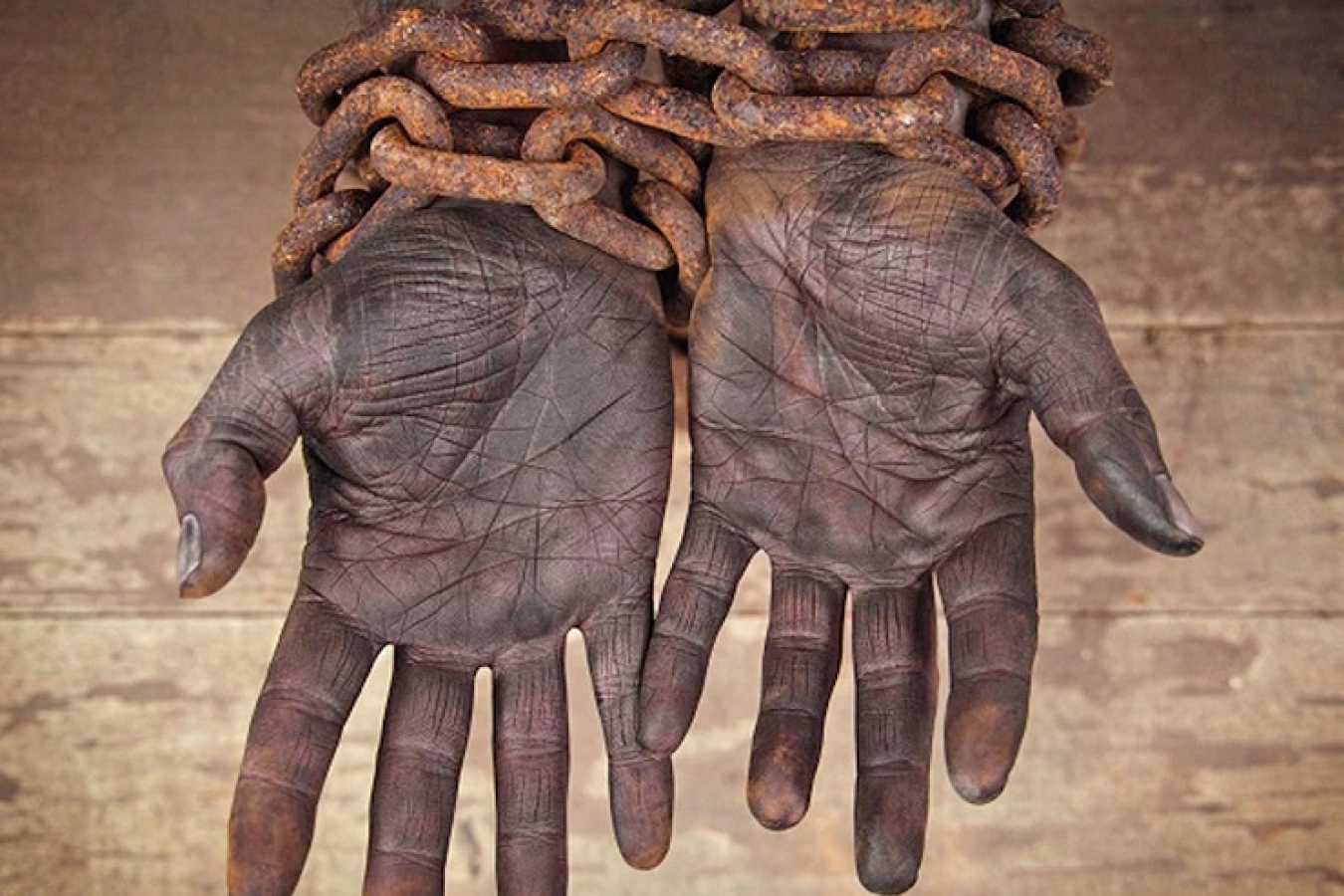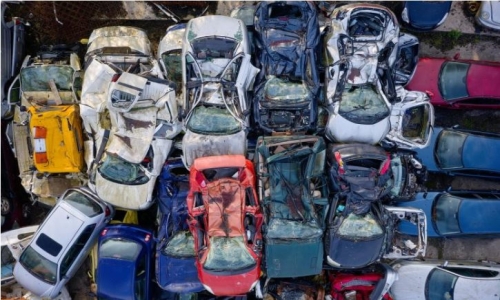


 3:50:57
3:50:57  2018-12-02
2018-12-02  1578
1578

According to the UN's International Calendar, today (Dec. 2) is the International Day for the Abolition of Slavery. Hence it is suitable to identify this transcending issue and look at possible solutions to end it.
Throughout school we learned that slavery only exists in a few parts in the world and refers to a condition in which individuals are owned by others, who control where they live and at what they work.
Now this was slavery back in the day.
Sad thing is that it still exists but has evolved into what is called modern slavery.
To be a slave is to be owned by another person. A slave is a human being classed as property and who is forced to work for nothing. An enslaved person is a human being who is made to be a slave. This language is often used instead of the word slave, to refer to the person and their experiences and to avoid the use of dehumanizing language.
Beginning in the 17th century, millions of African people were kidnapped, enslaved, and shipped across the Atlantic to the Americas under horrific conditions. Nearly two million people died at sea during the agonizing journey.
Up until the 19th century, slavery was being utilized mainly in the Americas.
Then the 13th amendment in the constitution was passed and ratified, abolishing slavery across the nation. The 13th amendment states that nobody should work as a slave or involuntary servant, except if forced by law as punishment for a crime committed. This amendment was passed after the Civil War.
Slavery did not end with abolition in the 19th century. Instead, it changed its forms and continues to harm people in every country in the world.
Today slavery is less about people literally owning other people – although that still exists – but more about being exploited and completely controlled by someone else, without being able to leave.
Whether they are women forced into prostitution, men forced to work in agriculture or construction, children in sweatshops or girls forced to marry older men, their lives are controlled by their exploiters, they no longer have a free choice and they have to do as they’re told. They are in slavery.
According to the International Labor Organization (ILO) more than 40 million people worldwide are victims of modern slavery.
Someone is in modern slavery if they are:
Forms of modern slavery
Facts and figures:
Now why is all of this happening? What are some of the causes?
Now let’s mention some modern forms of slavery put into practice today.
North Korea
North Korea has carried out or enabled multiple forms of slavery. Its extensive state-sanctioned forced labor system interns tens of thousands of people in camps, while others are shipped abroad to work under close guard, unable to leave and paid little, if anything. Criminal networks and individuals profit off the black market, including through human trafficking. In North Korea, women are sold into marriage for prices ranging from $150 to $1,500, and defectors to neighboring China are often sexually exploited amid growing demand for brides.
Democratic Republic of Congo (DRC)
There are more than 473,000 refugees and 3.9 million internally displaced people in the DRC. Eastern Congo is dominated by dozens of domestic and foreign-backed militias, which wield power over much of the country’s lucrative natural resources. The DRC is the world’s largest producer of cobalt and also has vast reserves of gold, diamonds and other minerals. These natural resources have created a profit motive for traffickers and militias to exploit vulnerable communities.
Amid civil war, women and children have been the victims of sexual slavery, rape has been used as a weapon, and boys have been forced to serve as soldiers in armed groups.
Thailand
The fishing industry in Southeast Asia, especially in Thailand, has been notorious for severe labor abuses. With eleven of the world’s largest fisheries in Asia, labor is in heavy demand. These fisheries often employ migrants from Bangladesh, Cambodia, Indonesia, Laos, Myanmar, the Philippines, and Vietnam.
Those employed in the Thai fishing industry are often subject to exploitation and abuse, including unclear contracts, withheld wages, and dangerous working conditions. Escapees have reported threats of violence, beatings, and sexual abuse, as well as the execution of their shipmates.
Iraq and Syria
Of course, let’s not forget Iraq and Syria a few years ago with the rise of the self-proclaimed Islamic State (ISIS). Violence in Iraq and Syria has left residents of many communities at risk of capture or enslavement. ISIS terrorists captured thousands of women and displaced hundreds of thousands of others in different areas. During their occupation, which ended in 2017, militants instituted slavery involving the sexual exploitation of women and girls of all faiths. They were forced into sexual slavery, sold in markets or gifted by commanders to fighters as brides. Some were sold at prices between $200 and $1,500. Captives were also forced into domestic servitude, cooking, cleaning, and, at times, raising children.
Now how can we help end all of this?
According to theodysseyonline.com, here are 10 ways to help end modern day slavery:
1. Be informed.
Learn about modern-day slavery’s existence, how to identify the signs of victimization and the different forms under which it may appear. This helps ease your identification of exploitation if you ever bear witness to a suspicious or potential trafficking incident and is the first step which must be taken to further your antislavery advocacy.
2. Help keep others knowledgeable.
Often times the most underrated form of activism, spreading awareness can be effective in mobilizing individuals and making them more involved in this global fight for human rights. It can be as simple as following the latest news on modern-day slavery and sharing it with friends on social media.
3. Call for help.
Keep the National Human Trafficking Resource Center’s 24/7 confidential hotline handy. Saving this number in your contacts and using it whenever suspicious of having seen a victim of human trafficking is one of the easiest and most effective ways to aid law enforcement officials in uncovering exploitation, bringing traffickers to justice and victims to freedom and restoration.
4. Be a conscious consumer.
Realize that modern-day slavery is in our backyards, not only exploiting our neighbors, but also plaguing our supply chains and staining our commerce. Learn about your slavery footprint and help to disseminate knowledge on the use of forced and child labor in the supply chain to increase overall consumer awareness.
5. Consume with a conscience.
Purchase Fair Trade certified goods which guarantee that no slavery was used in the creation of the product. You can even launch a Fair Trade campaign in your town or church or contact and petition your favorite brands and stores to begin producing and carrying Fair Trade.
6. Volunteer your time.
Volunteer or intern with antislavery organizations to get hands-on experience in combating this human rights issue. You can even support local anti-trafficking initiatives by volunteering in community awareness events which are truly gratifying experiences that help inform individuals previously unfamiliarized with the issue.
7. Organize a local fundraiser.
Even if you do not have the personal time to spare for volunteering in the community, you can donate to an anti-trafficking organization, such as International Justice Mission or Not for Sale, to help advance their human rights missions. Simply forgoing your daily cup of coffee (in exchange for a Fair Trade version at home) can translate to nearly $1,500 of donations a year!
8. Empower and invest in trafficking survivors.
Businesses can play a big role in a trafficking survivor’s path to restoration by offering jobs, internships, scholarships or other opportunities to those adversely impacted by modern-day slavery.
9. Take action on campus.
Join an anti-slavery student organization or club that helps spread awareness about the issue on campus. And if your school does not already have a club, start one! Be the catalyst for change by starting a very important discussion at your school about ensuring freedom for all.
10. Be politically aware and proactive.
Contact or write to your local, state and/or federal government representatives to see what they are doing to combat human trafficking domestically and abroad.
If you know anyone suffering from modern slavery, please help them.
Inshallah together we can help end modern slavery in its entirety.
As Article 4 of the Universal Declaration of Human Rights, says,
“No one shall be held in slavery or servitude; slavery and the slave trade shall be prohibited in all their forms.”
Reality Of Islam |
|

Researchers

A new chip-

A large inf

Choosing th
 9:3:43
9:3:43
 2018-11-05
2018-11-05
10 benefits of Marriage in Islam
 7:5:22
7:5:22
 2019-04-08
2019-04-08
benefits of reciting surat yunus, hud &
 9:45:7
9:45:7
 2018-12-24
2018-12-24
advantages & disadvantages of divorce
 11:35:12
11:35:12
 2018-06-10
2018-06-10
 6:0:51
6:0:51
 2018-10-16
2018-10-16
 1:16:44
1:16:44
 2018-05-14
2018-05-14
 9:42:16
9:42:16
 2022-10-19
2022-10-19
 2:13:43
2:13:43
 2022-05-27
2022-05-27
 12:10:56
12:10:56
 2022-11-17
2022-11-17
 6:0:8
6:0:8
 2023-03-19
2023-03-19
 8:25:12
8:25:12
 2022-03-09
2022-03-09
 10:43:56
10:43:56
 2022-06-22
2022-06-22
 5:41:46
5:41:46
 2023-03-18
2023-03-18
| LATEST |